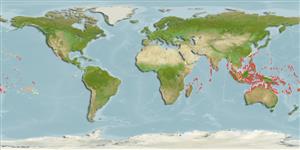>
Holocentriformes (Squirrelfishes, soldierfishes) >
Holocentridae (Squirrelfishes, soldierfishes) > Myripristinae
Etymology: Myripristis: Greek, myros, -ou = male of morey eel + Greek, pristis = saw (Ref. 45335).
More on author: Bleeker.
Environment: milieu / climate zone / depth range / distribution range
Écologie
marin récifal; profondeur 1 - 30 m (Ref. 9710). Tropical; 30°N - 23°S
Indo-Pacific: East Africa south to Natal, South Africa and east to the Line, Society, and Tuamoto islands, north to the Ryukyu Islands, south to the Great Barrier Reef. It has not been reported from the Red Sea, Gulf of Aden, Oman, or the Persian Gulf and is absent in the Hawaiian Islands, Marquesas, Pitcairn Group, and Easter Island (Ref. 12419).
Taille / Poids / Âge
Maturity: Lm ? range ? - ? cm
Max length : 35.0 cm TL mâle / non sexé; (Ref. 30573); common length : 25.0 cm TL mâle / non sexé; (Ref. 6113)
Épines dorsales (Total) : 11; Rayons mous dorsaux (Total) : 14 - 16; Épines anales: 4; Rayons mous anaux: 12 - 14. Pale salmon pink; edges of scales dorsally on body deep blue to black; median fins with broad black outer border. Inner pectoral fin axil naked except for one (rarely two) moderate scales on lower half (Ref. 2334).
Usually inhabits coral-rich areas of drop-offs and steep channel slopes from below the effects of surge to over 25 m. Occurs singly or in small groups, sometimes with other species (Ref. 9710, 48635). A nocturnal species hiding in caves or beneath ledges by day, feeds on plankton such as crab larvae at night. Maximum depth reported taken from Ref. 128797.
Life cycle and mating behavior
Maturities | Reproduction | Spawnings | Egg(s) | Fecundities | Larves
Randall, J.E. and D.W. Greenfield, 1996. Revision of the Indo-Pacific holocentrid fishes of the genus Myripristis, with descriptions of three new species. Indo-Pac. Fish. (25):61 p. (Ref. 12419)
Statut dans la liste rouge de l'IUCN (Ref. 130435)
Menace pour l'homme
Harmless
Utilisations par l'homme
Pêcheries: intérêt commercial mineur
Outils
Articles particuliers
Télécharger en XML
Sources Internet
Estimates based on models
Preferred temperature (Ref.
123201): 25.3 - 29.3, mean 28.5 °C (based on 2956 cells).
Phylogenetic diversity index (Ref.
82804): PD
50 = 0.5000 [Uniqueness, from 0.5 = low to 2.0 = high].
Bayesian length-weight: a=0.02089 (0.01313 - 0.03326), b=3.01 (2.88 - 3.14), in cm total length, based on LWR estimates for this species & Genus-body shape (Ref.
93245).
Niveau trophique (Ref.
69278): 3.4 ±0.45 se; based on food items.
Résilience (Ref.
120179): Haut, temps minimum de doublement de population inférieur à 15 mois (Preliminary K or Fecundity.).
Fishing Vulnerability (Ref.
59153): Low vulnerability (25 of 100).
Nutrients (Ref.
124155): Calcium = 51.8 [25.6, 154.1] mg/100g; Iron = 0.718 [0.313, 1.457] mg/100g; Protein = 18.4 [17.3, 19.6] %; Omega3 = 0.139 [0.059, 0.319] g/100g; Selenium = 29.6 [17.6, 55.5] μg/100g; VitaminA = 104 [40, 263] μg/100g; Zinc = 1.18 [0.77, 1.80] mg/100g (wet weight);
